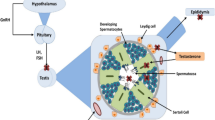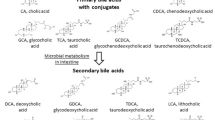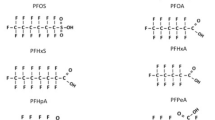Abstract
Dieldrin has been shown to induce liver tumors selectively in mice. Although the exact mechanism is not fully understood, previous studies from our laboratory and others have shown that dieldrin induced liver tumors in mice through a non-genotoxic mechanism acting on tumor promotion stage. Two studies were performed to examine the role of nuclear receptor activation as a possible mode of action (MOA) for dieldrin-induced mouse liver tumors. In the initial study, male C57BL/6 mice (6- to 8-week old) were treated with dieldrin in diet (10 ppm) for 7, 14, and 28 days. Phenobarbital (PB), beta-naphthoflavone (BNF) and Di (2-ethylhexyl) phthalate (DEHP) were included as positive controls in this study for evaluating the involvement of CAR (constitutive androstane receptor), AhR (aryl hydrocarbon receptor) or PPARα (peroxisome proliferator activated receptor alpha) in the MOA of dieldrin hepatocarcinogenesis. A significant increase in hepatocyte DNA synthesis (BrdU incorporation) was seen in treated mice compared with the untreated controls. Analysis of the expression of the nuclear receptor responsive genes revealed that dieldrin induced a significant increase in the expression of genes specific to CAR activation (Cyp2b10, up to 400- to 2700-fold) and PXR activation (Cyp3a11, up to 5- to 11-fold) over untreated controls. The AhR target genes Cyp1a1 and Cyp1a2 were also slightly induced (2.0- to 3.7-fold and 1.7- to 2.8-fold, respectively). PPARα activation was not seen in the liver following dieldrin treatment. In addition, consistent with previous studies in our lab, treatment with dieldrin produced significant elevation in the hepatic oxidative stress. In a subsequent study using CAR, PXR, and CAR/PXR knockout mice, we confirmed that the dieldrin-induced liver effects in mouse were only mediated by the activation of CAR receptor. Based on these findings, we propose that dieldrin induced liver tumors in mice through a nuclear receptor CAR-mediated mode of action. The previously observed oxidative stress/damage may be an associated or modifying factor in the process of dieldrin-induced liver tumor formation subsequent to the CAR activation.




Similar content being viewed by others
References
ATSDR (2002) Toxicological profile for Aldrin/Dieldrin. Atlanta, GA: Agency for Toxic Substances and Disease Registry, U.S. Department of Health and Human Services, Public Health Service
Bachowski S, Kolaja KL, Ketcham CA, Stevenson DE, Walborg EF, Klaunig JE (1997) Role of oxidative stress in the mechanism of dieldrin's hepatotoxicity. Ann Clin Lab Sci 27(3):196–209
Bachowski S, Xu Y, Stevenson DE, Walborg EF Jr, Klaunig JE (1998) Role of oxidative stress in the selective toxicity of dieldrin in the mouse liver. Toxicol Appl Pharmacol 150(2):301–309. https://doi.org/10.1006/taap.1998.8372
Baker TK, Bachowski S, Stevenson DE, Walborg EF Jr, Klaunig JE (1995) Modulation of gap junctional intercellular communication in rodent, monkey and human hepatocyte by nongenotoxic compounds. Prog Clin Biol Res 391:71–80
Budinsky RA, Schrenk D, Simon T et al (2014) Mode of action and dose–response framework analysis for receptor-mediated toxicity: the aryl hydrocarbon receptor as a case study. Crit Rev Toxicol 44(1):83–119. https://doi.org/10.3109/10408444.2013.835787
Cabral JR, Hall RK, Bronczyk SA, Shubik P (1979) A carcinogenicity study of pesticide dieldrin in hamsters. Cancer Lett 6(4–5):241–246
Cohen SM, Meek ME, Klaunig JE, Patton DE, Fenner-Crisp PA (2003) The human relevance of information on carcinogenic modes of action: overview. Crit Rev Toxicol 33(6):581–589 (Review)
Cohen SM, Gordon EB, Singh P, Arce GT, Nyska A (2010) Carcinogenic mode of action of folpet in mice and evaluation of its relevance to humans. Crit Rev Toxicol 40(6):531–545. https://doi.org/10.3109/10408441003742903
Corton JC, Cunningham ML, Hummer BT et al (2014) Mode of action framework analysis for receptor-mediated toxicity: the peroxisome proliferator-activated receptor alpha (PPARalpha) as a case study. Crit Rev Toxicol 44(1):1–49. https://doi.org/10.3109/10408444.2013.835784
Corton JC, Peters JM, Klaunig JE (2018) The PPARα-dependent rodent liver tumor response is not relevant to humans: addressing misconceptions. Arch Toxicol. 92(1):83–119
Crespi CL, Miller VP, Penman BW (1997) Microtiter plate assays for inhibition of human, drug-metabolizing cytochromes P450. Anal Biochem 248(1):188–190. https://doi.org/10.1006/abio.1997.2145
Davis KJ, Fitzhugh OG (1962) Tumorigenic potential of aldrin and dieldrin for mice. Toxicol Appl Pharmacol 4:187–189
Elcombe CR, Peffer RC, Wolf DC et al (2014) Mode of action and human relevance analysis for nuclear receptor-mediated liver toxicity: a case study with phenobarbital as a model constitutive androstane receptor (CAR) activator. Crit Rev Toxicol 44(1):64–82. https://doi.org/10.3109/10408444.2013.835786
Eldridge SR, Tilbury LF, Goldsworthy TL, Butterworth BE (1990) Measurement of chemically induced cell proliferation in rodent liver and kidney: a comparison of 5-bromo-2'-deoxyuridine and [3H]thymidine administered by injection or osmotic pump. Carcinogenesis 11(12):2245–2251
Hoivik DJ, Qualls CW Jr, Mirabile RC et al (2004) Fibrates induce hepatic peroxisome and mitochondrial proliferation without overt evidence of cellular proliferation and oxidative stress in cynomolgus monkeys. Carcinogenesis 25(9):1757–1769. https://doi.org/10.1093/carcin/bgh182
Holsapple MP, Pitot HC, Cohen SM et al (2006) Mode of action in relevance of rodent liver tumors to human cancer risk. Toxicol Sci 89(1):51–56. https://doi.org/10.1093/toxsci/kfj001
Hooker EP, Fulcher KG, Gibb HJ (2014) Aldrin and Dieldrin: a reevaluation of the cancer and noncancer dose–response assessments. Risk Anal 34(5):865–878. https://doi.org/10.1111/Risa.12145
Klaunig JE (2013) Chemical carcinogenesis. In: Klaassen CD (ed) In Casarett and Doull's toxicology the basic science of poisons, 8th edn. McGraw-Hill Medical Publishing Division, New York
Klaunig JE, Ruch RJ (1987) Strain and species effects on the inhibition of hepatocyte intercellular communication by liver tumor promoters. Cancer Lett 36(2):161–168
Klaunig JE, Wang Z (2018) Chemical carcinogenesis. In: Klaassen CD (ed) In Casarett and Doull's toxicology the basic science of poisons, 9th edn. McGraw-Hill Medical Publishing Division, New York
Klaunig JE, Xu Y, Isenberg JS et al (1998a) The role of oxidative stress in chemical carcinogenesis. Environ Health Perspect 106:289–295. https://doi.org/10.2307/3433929
Klaunig JE, Xu Y, Isenberg JS, Bachowski S, Kolaja KL, Jiang J, Stevenson DE, Walborg EF Jr (1998b) The role of oxidative stress in chemical carcinogenesis. Environ Health Perspect 106(Suppl 1):289–295
Kolaja KL, Klaunig JE (1997) Vitamin E modulation of hepatic focal lesion growth in mice. Toxicol Appl Pharmacol 143(2):380–387
Kolaja KL, Stevenson DE, Johnson JT, Walborg EF Jr, Klaunig JE (1995a) Hepatic effects of dieldrin and phenobarbital in male B6C3F1 mice and Fisher 344 rats: species selective induction of DNA synthesis. Prog Clin Biol Res 391:397–408
Kolaja KL, Stevenson DE, Walborg EF Jr, Klaunig JE (1995b) The effect of dieldrin and phenobarbital on preneoplastic hepatic lesion growth in male F344 rat and B6C3F1 mouse. Prog Clin Biol Res 391:409–423
Kolaja KL, Stevenson DE, Johnson JT, Walborg EF Jr, Klaunig JE (1996a) Subchronic effects of dieldrin and phenobarbital on hepatic DNA synthesis in mice and rats. Fundam Appl Toxicol 29(2):219–228
Kolaja KL, Stevenson DE, Walborg EF Jr, Klaunig JE (1996b) Reversibility of promoter induced hepatic focal lesion growth in mice. Carcinogenesis 17(7):1403–1409
Kolaja KL, Stevenson DE, Walborg EF Jr, Klaunig JE (1996c) Selective dieldrin promotion of hepatic focal lesions in mice. Carcinogenesis 17(6):1243–1250
Lake BG (2018) Human relevance of rodent liver tumour formation by constitutive androstane receptor (CAR) activators. Toxicol Res (Camb) 7(4):697–717
Lipsky MM, Trump BF, Hinton DE (1989) Histogenesis of dieldrin and DDT-induced hepatocellular carcinoma in Balb/c mice. J Environ Pathol Toxicol Oncol 9(1):79–93
Livak KJ, Schmittgen TD (2001) Analysis of relative gene expression data using real-time quantitative PCR and the 2(-Delta Delta C(T)) method. Methods 25(4):402–408. https://doi.org/10.1006/meth.2001.1262
Meek ME, Klaunig JE (2010) Proposed mode of action of benzene-induced leukemia: interpreting available data and identifying critical data gaps for risk assessment. Chem Biol Interact 184(1–2):279–285
Meierhenry EF, Ruebner BH, Gershwin ME, Hsieh LS, French SW (1981) Mallory body formation in hepatic nodules of mice ingesting dieldrin. Lab Invest 44(4):392–396
Meierhenry EF, Ruebner BH, Gershwin ME, Hsieh LS, French SW (1983) Dieldrin-induced mallory bodies in hepatic tumors of mice of different strains. Hepatology 3(1):90–95
NCI (1978a) Bioassay of dieldrin for possible carcinogenicity. Natl Cancer Inst Carcinog Tech Rep Ser 22:1–50
NCI (1978b) Bioassays of aldrin and dieldrin for possible carcinogenicity. Natl Cancer Inst Carcinog Tech Rep Ser 21:1–184
NRC (1996) Guide for the care and use of laboratory animals. Institute of Laboratory Animal Research, Commission on Life Sciences, National Research Council, Oslo
Poosch MS, Yamazaki RK (1986) Determination of peroxisomal fatty acyl-CoA oxidase activity using a lauroyl-CoA-based fluorometric assay. Biochim Biophys Acta 884(3):585–593
Rooney J, Oshida K, Kumar R, Baldwin W, Corton C (2019) Chemical activation of the constitutive androstane receptor leads to activation of oxidant-induced Nrf2. Toxicol Sci 167(1):172–189
Smith PK, Krohn RI, Hermanson GT et al (1985) Measurement of protein using bicinchoninic acid. Anal Biochem 150(1):76–85
Stevenson DE, Kehrer JP, Kolaja KL, Walborg EF Jr, Klaunig JE (1995) Effect of dietary antioxidants on dieldrin-induced hepatotoxicity in mice. Toxicol Lett 75(1–3):177–183
Stevenson DE, Walborg EF Jr, North DW et al (1999) Monograph: reassessment of human cancer risk of aldrin/dieldrin. Toxicol Lett 109(3):123–186
Stresser DM, Turner SD, Blanchard AP, Miller VP, Crespi CL (2002) Cytochrome P450 fluorometric substrates: identification of isoform-selective probes for rat CYP2D2 and human CYP3A4. Drug Metab Dispos 30(7):845–852
Tennekes HA, Wright AS, Dix KM, Koeman JH (1981) Effects of dieldrin, diet, and bedding on enzyme function and tumor incidence in livers of male CF-1 mice. Cancer Res 41(9 Pt 1):3615–3620
Wang Z, Neal BH, Lamb JC, Klaunig JE (2015) Mechanistic investigation of toxaphene induced mouse liver tumors. Toxicol Sci 147(2):549–561
Wang Z, Li X, Wu Q, Lamb JC 4th, Klaunig JE (2017) Toxaphene-induced mouse liver tumorigenesis is mediated by the constitutive androstane receptor. J Appl Toxicol 37(8):967–975
Acknowledgements
The research work was supported in part by Internal Funding to the Klaunig Lab at Indiana University. This manuscript is dedicated to two distinguished senior toxicologists, Drs. Donald Stevenson and Earl Walborg who introduced our lab to the dieldrin problem in the late 1980s.
Author information
Authors and Affiliations
Corresponding author
Ethics declarations
Conflict of interest
The authors declare that they have no conflicts of interest.
Additional information
Publisher's Note
Springer Nature remains neutral with regard to jurisdictional claims in published maps and institutional affiliations.
Electronic supplementary material
Below is the link to the electronic supplementary material.
Rights and permissions
About this article
Cite this article
Wang, Z., Wu, Q., Li, X. et al. Constitutive androstane receptor (CAR) mediates dieldrin-induced liver tumorigenesis in mouse. Arch Toxicol 94, 2873–2884 (2020). https://doi.org/10.1007/s00204-020-02781-8
Received:
Accepted:
Published:
Issue Date:
DOI: https://doi.org/10.1007/s00204-020-02781-8




